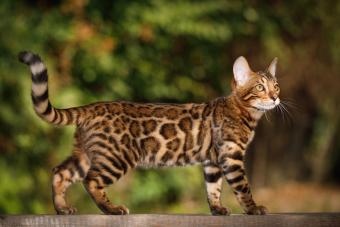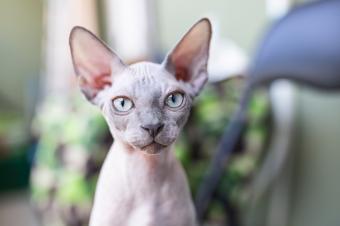
Bengals aren't your average house cat. Instead, the beautiful hybrid bengal cat breed is a cross between an Asian leopard cat and a domestic house cat. Despite their domestication, Bengal cats look like little leopards. They've even retained many wild traits, like their low-shedding coats, muscular bodies, and love of water. There's a reason Bengals are exploding in popularity, and it isn't because these cats are boring.
Bengal Cats At a Glance
- Lifespan: 12 to 16 years
- Average weight: 8 to 15 pounds
- Average height: 13 to 16 inches
- Personality: Friendly, intelligent, confident, social, affectionate, loyal
- Activity level: Very energetic
- Ease of training: Highly trainable
- Hypoallergenic?: Nearly hypoallergenic
- Coat length: Short
- Shedding level: Very mild shedders
- Origin: Cross between Asian Leopard Cat and house cat breeds
Do Bengal Cats Make Good Pets?
Bengal cats are very popular pets because they have a ton of great qualities. Even though they have wild Asian leopard cat genes, pet Bengals are very much domesticated. Bengals make friendly and entertaining pets.
Because of their highly energetic nature, these cats need a lot of attention. Bengals are not lap cats by any means. They typically do very well in households with other cats, dogs, and children.
Bengal Cat Personality

Bengals are known for acting like dogs. They're one of the most intelligent cat breeds, and because they aim to please their owners, they are highly trainable. Many people teach their Bengals tricks, such as how to sit, high-five, shake, spin, or meow on command. Leash training is also popular among Bengal owners, but because Bengals have slender bodies and slick fur, a special escape-proof harness is often recommended for this breed.
- Affection Level: High
- Friendliness: High
- Kid-friendly: Yes, socialize early
- Pet-friendly: Yes, socialize early
- Exercise Needs: High
- Playfulness: High
- Energy Level: High
- Trainability: High
- Intelligence: High
- Tendency to Vocalize: Moderate to High
Bengal Body Shape and Size
Members of the breed generally have a muscular body similar to a leopard. They are not so much big as they are tall. Bengals stand an average of 13 to 16 inches at the shoulder, but their weight is about the same as an average house cat. What really sets them apart from other cats is their stunning coat. Bengals have glossy, silky hair that sits flat, almost like a pelt.
Bengal Cat Colors
You can find Bengal cats in a number of stunning shades. Some are considered traditional colors, whereas others are "non-standard" but are still incredibly attractive. A cat's coat color, as well as the pattern, can contribute to how much you'll pay for a Bengal kitten.
Some Bengals even have what is known as a "glitter" coat. Bengals with this trait have softer coats with a special sheen, where the colors seem to sparkle. You can pick out iridescent, golden or silver flecks in their coat. This is a rare, recessive genetic trait - known as the Fgfr2 mutation - and it is highly desirable among Bengal breeders and owners.
The gene that controls the glitter trait is recessive, so Bengals must have two copies of the gene - one from each parent - to sport a glitter coat.
Silver

Silver Bengal cats are rare. Their main body shade or "ground" color can range from white to a dark gray shade. Most silver Bengals have gold or green eyes.
Snow

Like the silver shade, snow Bengals are also difficult to find. Their ground colors can be anywhere from an ivory shade to a light tan. This light color is the result of a pigment-blocking gene that came from using Siamese cats to breed Bengals.
Brown

Brown is the most popular color Bengals are found in. The brown shade can range from light brown to a rich red brown. Many have hints of orange in the color. Most brown Bengals have gold or green eyes.
Charcoal

Charcoal isn't a recognized breed color, but some breeders produce these cats. Charcoal Bengals have dark grey fur with characteristic Bengal markings. Many also have a dark "mask" marking on their face.
Black

Black Bengal cats look like little black panthers. These cats have silky black fur with barely visible rosettes or marble markings.
Blue
Blue is the rarest Bengal color and another that is not considered standard. The coat of a blue Bengal is a stunning bluish-grey color, and their markings are typically a slate blue. If you're able to find one of these rare Bengals, you can expect to pay a lot for it!
Bengal Coat Patterns

Bengal cats come in two standard patterns: spotted and marbled.
Spotted or Rosette: Bengal spots can appear as monochrome spots, but most are considered rosettes. Rosettes are spots with two distinct shades, usually with a darker interior with a lighter interior. Bengals can have different types of rosettes, including ones shaped like donuts, clusters, arrowheads, paw prints, and even hearts.

Marbled: Marbled Bengals are another distinct pattern and one that's relatively rare. The marbling usually involves three different shades, referred to as "tri-color marbles," and typically has a horizontal pattern. Some Bengal cats have both spots and marbling in their coat pattern.
Bengal Coat Type
Short-haired
Most Bengals have short-haired coats. Actually, only short-haired Bengals are considered part of the breed, according to The International Cat Association (TICA) breed standard. Their coat is quite plush but is very easy to maintain.
Long-haired
Yes, long-haired Bengal cats do exist. They're known as Cashmere Bengals.
Long-haired Bengals are identical to true Bengal cats in every way, except they have long, silky hair. Many have a fluffy mane around their neck, so they look like a cross between a leopard and a lion. Breeders have attempted to "breed out" the gene responsible for long hair because it wasn't a desirable trait, but Cashmere cat enthusiasts are trying to have this gorgeous cat recognized as a separate breed.
History and Origin of the Bengal
The Bengal cat is a hybrid cross between an Asian leopard cat and a domestic house cat. Several people are said to have bred these two felines around the same time for various reasons, including Dr. Willard Centerwall and Bill Engler. Bill Engler is noted as saying his goal was, "to create a small exotic cat that was beautiful and had the disposition that was suitable for a pet house cat," and these attempts were ultimately successful.
However, it's Jean Mill, a Californian cat breeder, who is credited with creating the Bengal that we know today. The Bengal was recognized as a breed by The International Cat Association (TICA) in 1983. Since then, Bengals have gone on to win numerous cat show championships, and have become popular as pets. They have also become one of the most expensive cat breeds around.
Bengal Breed Care
Due to their energetic nature and dog-like personality, Bengals have some unique care requirements. Most of their care is similar to that of any other cat or kitten, with a few additions.
Exercise

Bengal cats are busy pets who need a lot of exercise. Aim to give your Bengal at least 30 to 60 minutes of exercise each day. You can do this through active play with wand toys or laser pointers, outdoor walks on a leash, or with a cat exercise wheel. Without enough physical and mental stimulation, your Bengal could turn to destructive behaviors, such as scratching or meowing excessively, so keep them engaged daily.
If your cat has a high prey drive, using a laser pointer for play may not be a good idea.
Grooming Needs
Bengals have low grooming needs. Because they're low-shedders and most have short hair, you won't need to brush your Bengal very often. Once or twice every week is adequate. This trait also makes the Bengal cat one of the few breeds that are nearly hypoallergenic.
Nutrition
Bengal cats have the same nutritional requirements as any other breed of cat. They are obligate carnivores who should eat a diet high in protein. However, due to a Bengal's high energy, they will need more calories than a lap cat. Find high-quality food for your cat's life stage (kitten, adult, senior) and feed them according to the feeding instructions provided.
Royal Canin does offer a breed-specific diet designed for Bengals. The formula includes a high protein content to help Bengals maintain their muscle mass, plus it isn't hard on their notoriously sensitive stomachs. Alternatively, many Bengal owners elect to cook for their cats or feed them raw diets. Speak to your veterinarian to find out what the best diet for your Bengal should be.
Bengal Cats as Pets
Bengal cats aren't for everyone, but they're excellent cats for the right person or family. If you're interested in a lap cat you can leave at home for most of the day, a Bengal isn't a good choice. However, if you want a smart, athletic cat you can train or walk on a leash, you should definitely consider a Bengal. Just know these gorgeous cats are costly and will keep regular veterinary visits, high-quality food, and enrichment toys for their lifetime of 12 to 16 years or more. But as any Bengal owner will tell you, it's well worth it.







